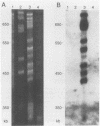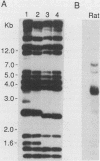Abstract
A repetitive DNA sequence, Rp-alpha, was isolated from rat-derived Pneumocystis carinii. The genome of rat-derived P. carinii contained 10 to 15 copies of Rp-alpha, which were located on most chromosomes, but no Rp-alpha could be detected in P. carinii derived from either humans or mice. Sequence analysis of two copies of the repeat showed them to be related but distinct. Each of them contained several copies of the 9-base sequence TAACCCTAA, arranged as direct repeats. Oligonucleotides consisting of multimers of this 9mer hybridized to the same set of chromosomes recognized by cloned copies of the Rp-alpha repeat. When used in DNA fingerprinting, the Rp-alpha repeat was capable of distinguishing between different isolates of rat-derived P. carinii.
Full text
PDF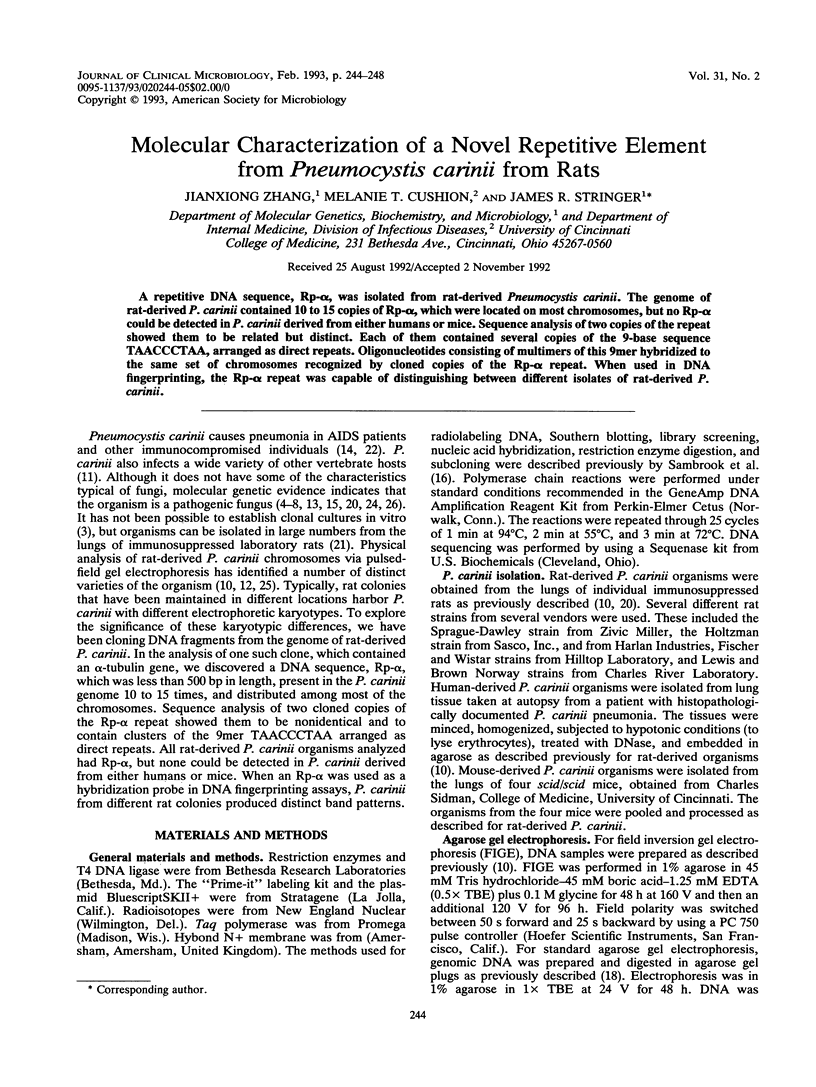
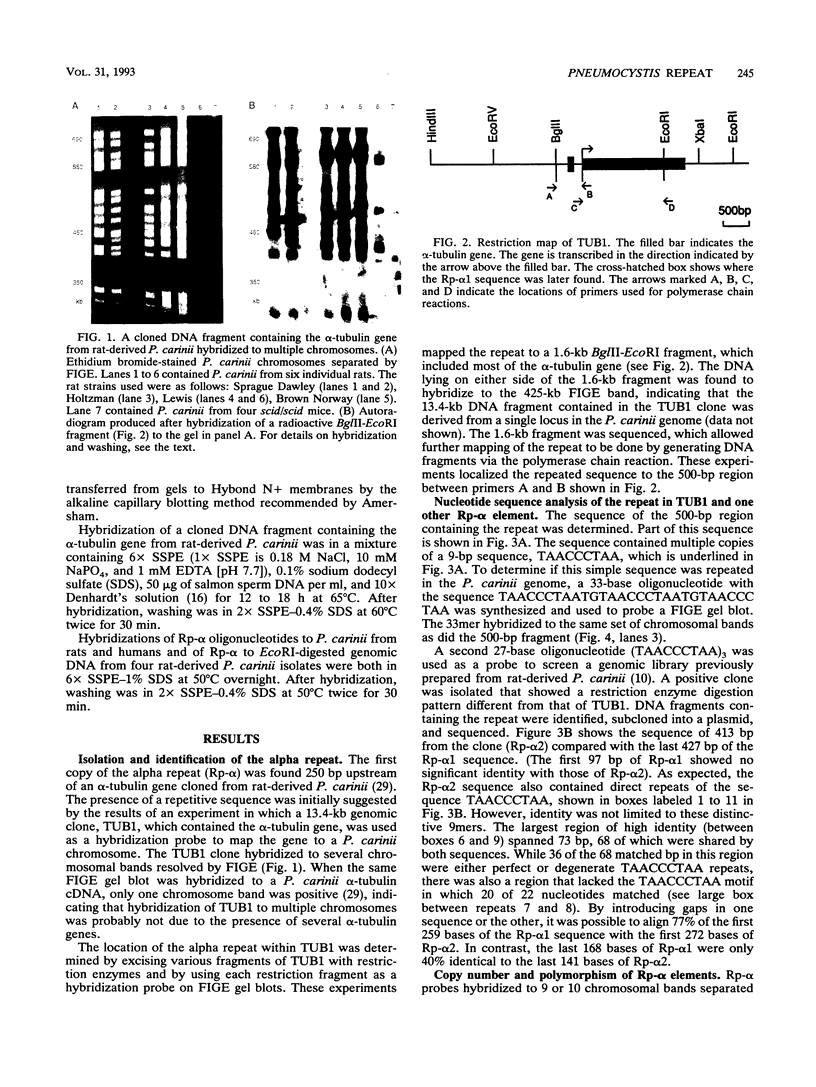
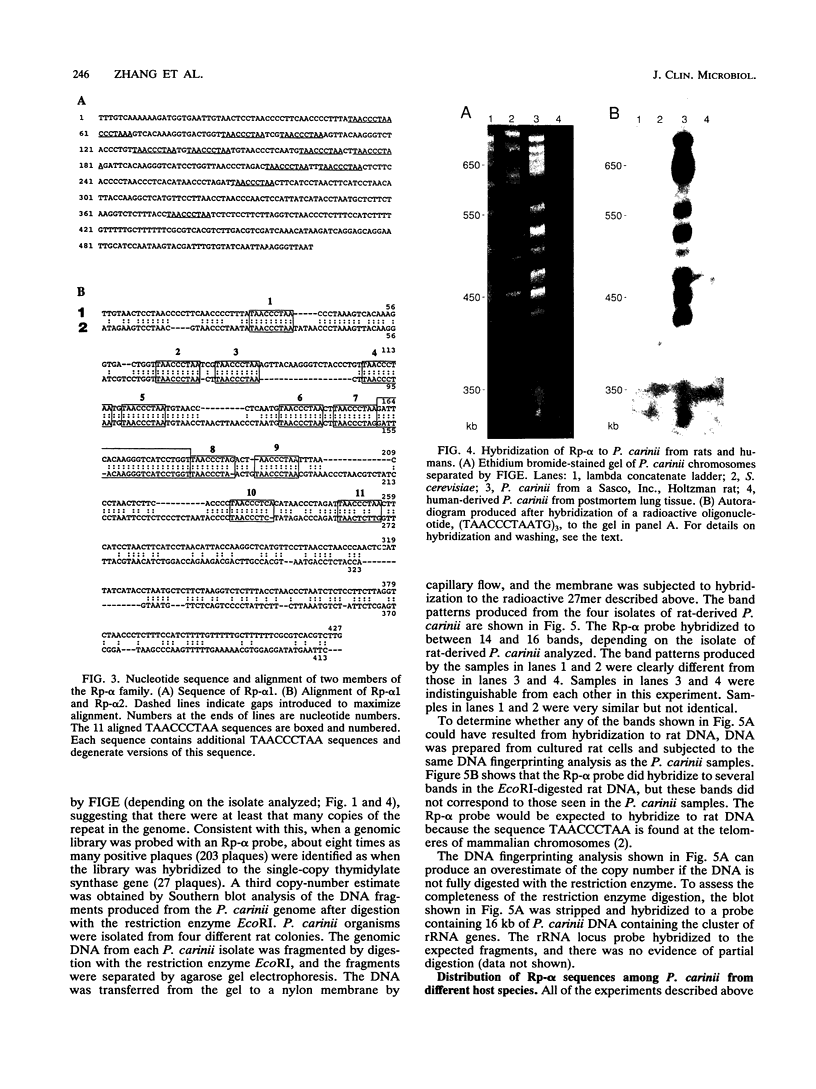
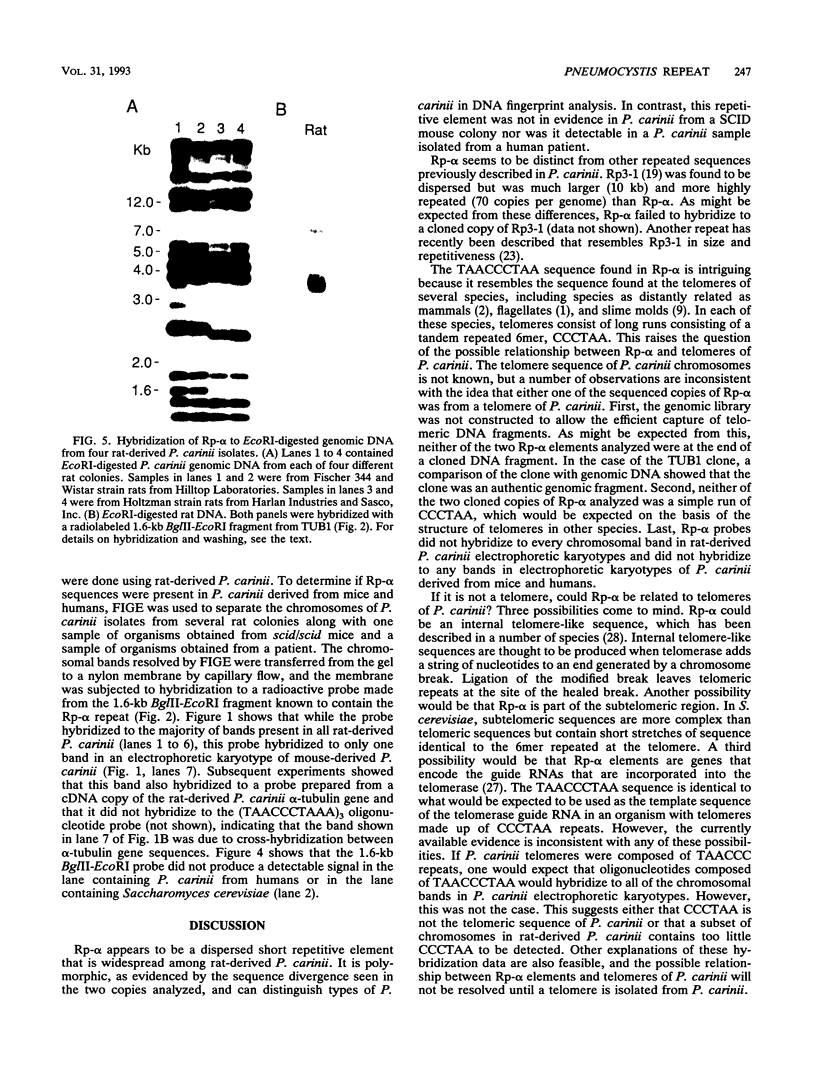
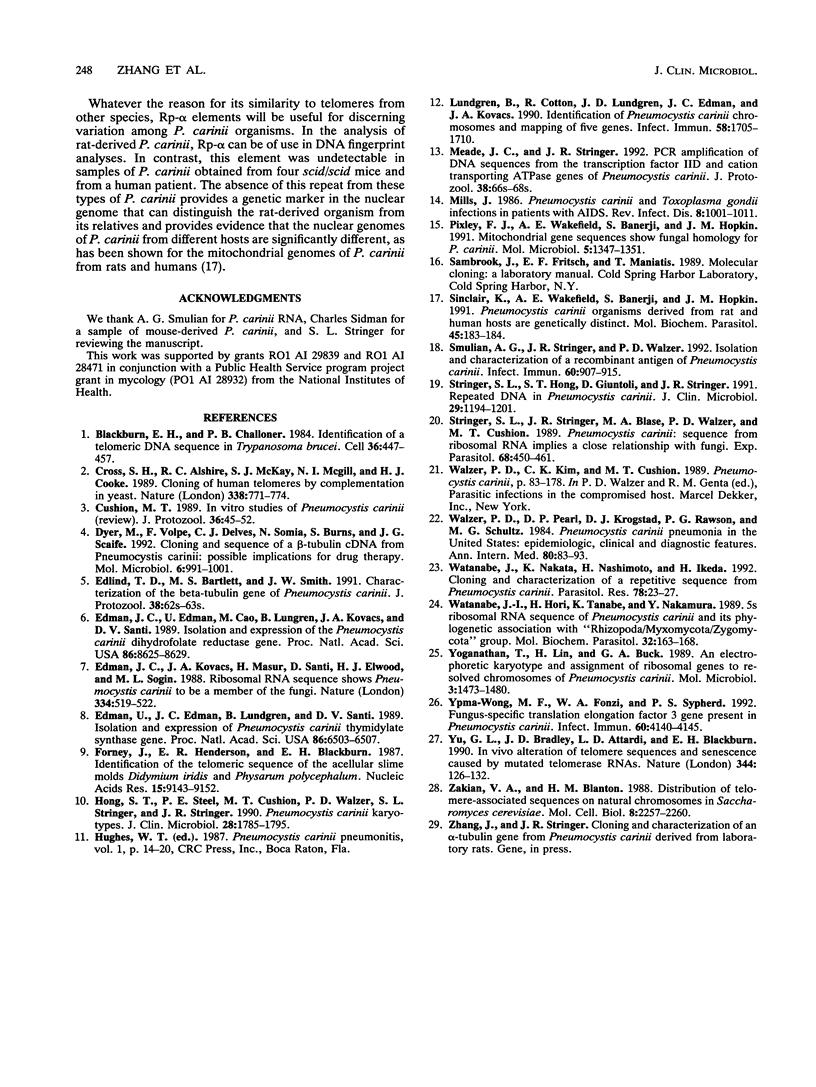
Images in this article
Selected References
These references are in PubMed. This may not be the complete list of references from this article.
- Blackburn E. H., Challoner P. B. Identification of a telomeric DNA sequence in Trypanosoma brucei. Cell. 1984 Feb;36(2):447–457. doi: 10.1016/0092-8674(84)90238-1. [DOI] [PubMed] [Google Scholar]
- Cross S. H., Allshire R. C., McKay S. J., McGill N. I., Cooke H. J. Cloning of human telomeres by complementation in yeast. Nature. 1989 Apr 27;338(6218):771–774. doi: 10.1038/338771a0. [DOI] [PubMed] [Google Scholar]
- Cushion M. T. In vitro studies of Pneumocystis carinii. J Protozool. 1989 Jan-Feb;36(1):45–52. doi: 10.1111/j.1550-7408.1989.tb02691.x. [DOI] [PubMed] [Google Scholar]
- Dyer M., Volpe F., Delves C. J., Somia N., Burns S., Scaife J. G. Cloning and sequence of a beta-tubulin cDNA from Pneumocystis carinii: possible implications for drug therapy. Mol Microbiol. 1992 Apr;6(8):991–1001. doi: 10.1111/j.1365-2958.1992.tb02165.x. [DOI] [PubMed] [Google Scholar]
- Edlind T. D., Bartlett M. S., Smith J. W. Characterization of the beta-tubulin gene of Pneumocystis carinii. J Protozool. 1991 Nov-Dec;38(6):62S–63S. [PubMed] [Google Scholar]
- Edman J. C., Edman U., Cao M., Lundgren B., Kovacs J. A., Santi D. V. Isolation and expression of the Pneumocystis carinii dihydrofolate reductase gene. Proc Natl Acad Sci U S A. 1989 Nov;86(22):8625–8629. doi: 10.1073/pnas.86.22.8625. [DOI] [PMC free article] [PubMed] [Google Scholar]
- Edman J. C., Kovacs J. A., Masur H., Santi D. V., Elwood H. J., Sogin M. L. Ribosomal RNA sequence shows Pneumocystis carinii to be a member of the fungi. Nature. 1988 Aug 11;334(6182):519–522. doi: 10.1038/334519a0. [DOI] [PubMed] [Google Scholar]
- Edman U., Edman J. C., Lundgren B., Santi D. V. Isolation and expression of the Pneumocystis carinii thymidylate synthase gene. Proc Natl Acad Sci U S A. 1989 Sep;86(17):6503–6507. doi: 10.1073/pnas.86.17.6503. [DOI] [PMC free article] [PubMed] [Google Scholar]
- Forney J., Henderson E. R., Blackburn E. H. Identification of the telomeric sequence of the acellular slime molds Didymium iridis and Physarum polycephalum. Nucleic Acids Res. 1987 Nov 25;15(22):9143–9152. doi: 10.1093/nar/15.22.9143. [DOI] [PMC free article] [PubMed] [Google Scholar]
- Hong S. T., Steele P. E., Cushion M. T., Walzer P. D., Stringer S. L., Stringer J. R. Pneumocystis carinii karyotypes. J Clin Microbiol. 1990 Aug;28(8):1785–1795. doi: 10.1128/jcm.28.8.1785-1795.1990. [DOI] [PMC free article] [PubMed] [Google Scholar]
- Lundgren B., Cotton R., Lundgren J. D., Edman J. C., Kovacs J. A. Identification of Pneumocystis carinii chromosomes and mapping of five genes. Infect Immun. 1990 Jun;58(6):1705–1710. doi: 10.1128/iai.58.6.1705-1710.1990. [DOI] [PMC free article] [PubMed] [Google Scholar]
- Meade J. C., Stringer J. R. PCR amplification of DNA sequences from the transcription factor IID and cation transporting ATPase genes in Pneumocystis carinii. J Protozool. 1991 Nov-Dec;38(6):66S–68S. [PubMed] [Google Scholar]
- Mills J. Pneumocystis carinii and Toxoplasma gondii infections in patients with AIDS. Rev Infect Dis. 1986 Nov-Dec;8(6):1001–1011. doi: 10.1093/clinids/8.6.1001. [DOI] [PubMed] [Google Scholar]
- Pixley F. J., Wakefield A. E., Banerji S., Hopkin J. M. Mitochondrial gene sequences show fungal homology for Pneumocystis carinii. Mol Microbiol. 1991 Jun;5(6):1347–1351. doi: 10.1111/j.1365-2958.1991.tb00781.x. [DOI] [PubMed] [Google Scholar]
- Sinclair K., Wakefield A. E., Banerji S., Hopkin J. M. Pneumocystis carinii organisms derived from rat and human hosts are genetically distinct. Mol Biochem Parasitol. 1991 Mar;45(1):183–184. doi: 10.1016/0166-6851(91)90042-5. [DOI] [PubMed] [Google Scholar]
- Smulian A. G., Stringer J. R., Linke M. J., Walzer P. D. Isolation and characterization of a recombinant antigen of Pneumocystis carinii. Infect Immun. 1992 Mar;60(3):907–915. doi: 10.1128/iai.60.3.907-915.1992. [DOI] [PMC free article] [PubMed] [Google Scholar]
- Stringer S. L., Hong S. T., Giuntoli D., Stringer J. R. Repeated DNA in Pneumocystis carinii. J Clin Microbiol. 1991 Jun;29(6):1194–1201. doi: 10.1128/jcm.29.6.1194-1201.1991. [DOI] [PMC free article] [PubMed] [Google Scholar]
- Stringer S. L., Stringer J. R., Blase M. A., Walzer P. D., Cushion M. T. Pneumocystis carinii: sequence from ribosomal RNA implies a close relationship with fungi. Exp Parasitol. 1989 May;68(4):450–461. doi: 10.1016/0014-4894(89)90130-6. [DOI] [PubMed] [Google Scholar]
- Walzer P. D., Perl D. P., Krogstad D. J., Rawson P. G., Schultz M. G. Pneumocystis carinii pneumonia in the United States. Epidemiologic, diagnostic, and clinical features. Ann Intern Med. 1974 Jan;80(1):83–93. doi: 10.7326/0003-4819-80-1-83. [DOI] [PubMed] [Google Scholar]
- Watanabe J., Hori H., Tanabe K., Nakamura Y. Phylogenetic association of Pneumocystis carinii with the 'Rhizopoda/Myxomycota/Zygomycota group' indicated by comparison of 5S ribosomal RNA sequences. Mol Biochem Parasitol. 1989 Jan 15;32(2-3):163–167. doi: 10.1016/0166-6851(89)90067-4. [DOI] [PubMed] [Google Scholar]
- Watanabe J., Nakata K., Nashimoto H., Ikeda H. Cloning and characterization of a repetitive sequence from Pneumocystis carinii. Parasitol Res. 1992;78(1):23–27. doi: 10.1007/BF00936176. [DOI] [PubMed] [Google Scholar]
- Yoganathan T., Lin H., Buck G. A. An electrophoretic karyotype and assignment of ribosomal genes to resolved chromosomes of Pneumocystis carinii. Mol Microbiol. 1989 Nov;3(11):1473–1480. doi: 10.1111/j.1365-2958.1989.tb00132.x. [DOI] [PubMed] [Google Scholar]
- Ypma-Wong M. F., Fonzi W. A., Sypherd P. S. Fungus-specific translation elongation factor 3 gene present in Pneumocystis carinii. Infect Immun. 1992 Oct;60(10):4140–4145. doi: 10.1128/iai.60.10.4140-4145.1992. [DOI] [PMC free article] [PubMed] [Google Scholar]
- Yu G. L., Bradley J. D., Attardi L. D., Blackburn E. H. In vivo alteration of telomere sequences and senescence caused by mutated Tetrahymena telomerase RNAs. Nature. 1990 Mar 8;344(6262):126–132. doi: 10.1038/344126a0. [DOI] [PubMed] [Google Scholar]
- Zakian V. A., Blanton H. M. Distribution of telomere-associated sequences on natural chromosomes in Saccharomyces cerevisiae. Mol Cell Biol. 1988 May;8(5):2257–2260. doi: 10.1128/mcb.8.5.2257. [DOI] [PMC free article] [PubMed] [Google Scholar]




